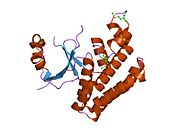| OTUB2 |
|---|
 |
| Available structures |
|---|
| PDB | Ortholog search: PDBe RCSB |
|---|
| List of PDB id codes |
|---|
1TFF, 4FJV |
|
|
| Identifiers |
|---|
| Aliases | OTUB2, C14orf137, OTB2, OTU2, OTU deubiquitinase, ubiquitin aldehyde binding 2 |
|---|
| External IDs | OMIM: 608338; MGI: 1915399; HomoloGene: 57056; GeneCards: OTUB2; OMA:OTUB2 - orthologs |
|---|
| Gene location (Human) |
|---|
 | | Chr. | Chromosome 14 (human)[1] |
|---|
| | Band | 14q32.12 | Start | 94,026,340 bp[1] |
|---|
| End | 94,048,930 bp[1] |
|---|
|
| Gene location (Mouse) |
|---|
 | | Chr. | Chromosome 12 (mouse)[2] |
|---|
| | Band | 12|12 E | Start | 103,354,941 bp[2] |
|---|
| End | 103,372,609 bp[2] |
|---|
|
| RNA expression pattern |
|---|
| Bgee | | Human | Mouse (ortholog) |
|---|
| Top expressed in | - testicle
- left testis
- right testis
- skin of leg
- ventricular zone
- gonad
- skin of abdomen
- ganglionic eminence
- placenta
- islet of Langerhans
|
| | Top expressed in | - seminiferous tubule
- spermatid
- esophagus
- primary oocyte
- lip
- dentate gyrus of hippocampal formation granule cell
- zygote
- Region I of hippocampus proper
- lacrimal gland
- secondary oocyte
|
| | More reference expression data |
|
|---|
| BioGPS |  | | More reference expression data |
|
|---|
|
| Gene ontology |
|---|
| Molecular function | - thiol-dependent deubiquitinase
- peptidase activity
- cysteine-type peptidase activity
- NEDD8-specific protease activity
- ubiquitin binding
- protein binding
- hydrolase activity
| | Cellular component | | | Biological process | - protein deubiquitination
- protein K63-linked deubiquitination
- protein K48-linked deubiquitination
- proteolysis
- protein K11-linked deubiquitination
| | Sources:Amigo / QuickGO |
|
| Orthologs |
|---|
| Species | Human | Mouse |
|---|
| Entrez | | |
|---|
| Ensembl | |
|---|
ENSG00000089723
ENSG00000277276 |
| |
|---|
| UniProt | | |
|---|
| RefSeq (mRNA) | | |
|---|
| RefSeq (protein) | | |
|---|
| Location (UCSC) | Chr 14: 94.03 – 94.05 Mb | Chr 12: 103.35 – 103.37 Mb |
|---|
| PubMed search | [3] | [4] |
|---|
|
| Wikidata |
| View/Edit Human | View/Edit Mouse |
|

 1tff: Structure of Otubain-2
1tff: Structure of Otubain-2


















